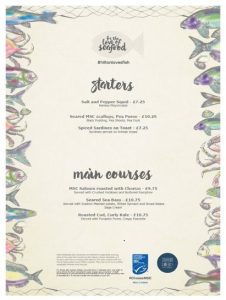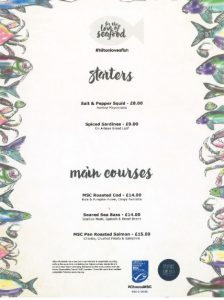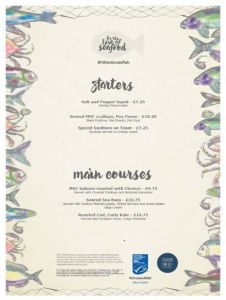Eco-babel: In her Ethical Living column in the Observer newspaper Sunday magazine, Lucy Siegel provides an Eco guide to buying fish. Lucy says she is more laid back about buying ethical fish than other proteins because she trusts seafood eco-labels. She says that policing some 3 million vessels across the globe is not easy but that we do have some accountability including GlobalGAP, the label for certified aquaculture and the blue tick (awarded by the Marine Stewardship Council to 281 sustainable fisheries across the world). Lucy is clearly well informed!!!
Lucy also mentions Anya Hart Dyke of asktheq.org who wanted to find out if shoppers navigating seafood cabinets using the MCS’s (she actually wrote MSC) Good Fish Guide are likely to end up with the real (sustainable, responsible) deal. According to Lucy, the answer is not as retail labelling can be misleading. Anya tested farmed sea bass, prawns and salmon labelled as responsibly farmed or responsibly sourced and found that the majority only reached a number 3 rating in the MCS’s (this time listed correctly) guide. This advises that far from being sustainable, they should be eaten ‘only occasionally’.
According to Lucy, we can’t tolerate assurances that don’t add up. It’s simply too important so retailers must get their facts straight.
We, at Callander McDowell have a problem with Lucy’s column. She automatically assumes that it is the retailers who have got their facts wrong. We, on the other hand, think that if there is a problem, then it lies with the Marine Conservation Society and their Good Fish Guide. We can only wonder what makes the people at the MCS any better qualified than us, the industry, or the retailers to ascertain whether fish are produced sustainably or responsibly or not? If anything, we think that it might be the MCS and other environmental organisations that are being misled, not us or the consumer.
One of the species that Anya Hart Dyke considered was farmed salmon. Farmed salmon is one of the most consumed fish in the UK. It is extremely popular. The MCS give it a rating of 3 out 5 meaning that there have concerns and they recommend that consumers eat it sparingly. (By comparison, the Seafood Watch guide in the US rates farmed salmon as a fish to avoid). We, wonder whether these concerns are misplaced and based largely on misinformation.
What saddens us at Callander McDowell, is that most of the dissemination of misinformation was deliberate. From about 2000, a number of US charitable foundations invested millions of dollars into a demarketing campaign against imported farmed salmon. The idea was to protect US wild salmon fisheries and the US way of life. The campaign deliberately tried to sway the US consumer from buying farmed salmon by pumping out a whole range of negative messages. The tone of the campaign can be judged by the name of just one of the websites – Farmed and Dangerous.
The campaign was exposed by Canadian researcher Vivian Krause who examined US tax returns for these foundations. The money was distributed through a number of organisations who then sub contracted some of the work. This way the negative messages permeated the environmental sector, as well as beyond US borders. Although consumers ignored the campaign and continued to buy as much farmed salmon as they liked, which was why the campaign eventually failed, the many negative messages generated remain firmly entrenched within the environmental sector, even those which are completely untrue. Consequently, consumer guides such as Seafood Watch red list pen raised farmed salmon. One of the reasons they give is the impact of sea lice from salmon farms on wild stocks. This week, our Dr Martin Jaffa spoke at Sea Lice 2016 in Westport, Co Mayo and described how most of the catches from west coast fisheries that are claimed to be in decline as a result of salmon farming were actually in decline long before salmon farming came to Scotland. Salmon farming was just a convenient scapegoat.
Fortunately, most consumers take no notice of the advice given in fish consumer guides. Instead, they recognise that the fish and seafood sold by the major retailers is produced both sustainably and responsibly. They don’t need consumer labels or guides to tell them otherwise.
Prevention better than cure: Undercurrent News report that Aquaculture Veteran Bjorn Myrseth spoke at the recent EAS conference in Edinburgh about the latest developments in the salmon industry and especially the Stadion Laks concept in which he is involved. This is one of a number of projects that are being proposed in Norway as a way of producing salmon without some of the major problems affecting the salmon industry today.
The Stadion Laks (literally Salmon Stadium) are large concrete basins into which water is pumped in at one end and discharged at the other. The water is drawn from a depth of about 15 metres which is below the typical layers inhabited by sea lice. The system is otherwise closed meaning that there should be no escapes, low feed conversions and leaner fish. Mr Myrseth told the meeting that the concrete structure, that should hold about 2,000 tonnes, should last a hundred years before requiring replacement.
Mr Myrseth also looked at some other projects that have been proposed. The investment required ranges from NOK 37 million to NOK 120 million per 1000 tonnes as compared to about NOK 4 million for a traditional net pen.
Over recent months, we have seen a number of different proposals and we are not impressed. Typically, they are all variations on some form of closed containment either on land or sea or somewhere in-between. All these proposals require huge investment.
Of course, the intention is to avoid the ever increasing production costs that continue to dog the industry but we are now wondering whether the industry is becoming too focused on these supposed solutions and perhaps are getting carried away with some of the ideas. We recently heard about an idea to have a freshwater reservoir inside a tank so the fish could delouse. We wonder if this is a step too far
We, at Callander McDowell, are great believers in prevention rather than cure. We understand the need for immediate solutions and thus the range of treatments and methods of physical lice removal. A whole industry has sprung up on the back of the industry’s problems with lice and therefore we see that the idea that a physical barrier between the salmon and the lice looks attractive.
However, we do not see that it is a case of either or. There are other solutions and perhaps some that are much easier and cheaper. Surely, it is better to adapt existing technology rather than start from scratch and have to step into the unknown.
One of the presentations given at the recent Sea Lice 2016 conference concerned the new Snorkel cage in which fish are encouraged to stay low in the cage and away from the infectious sea lice stages that tend to congregate near the surface. Fish can reach the surface through an enclosed tube so they can adjust their swim bladders but otherwise they remain out of reach of the lice. The results of trails showed that at 0 metres, fish were infected with about 15 lice. This fell to just 5 at 4 metres whilst at 12 metres, the louse load was no more than one. Typically, use of this cage reduced lice loads by over 75%.
We at Callander McDowell like this system because it emulates a concept we developed over twenty years ago but which failed to generate any interest. This involved feeding fish from the bottom of the cage rather than encouraging them to the surface to feed, where they immediately encountered infectious larval lice (https://www.youtube.com/watch?v=WNCHbuVCDJY). We suspect that most farmers could not get past the idea of the feeder, which was only a prototype and was never intended to take the experimental form. At the same time, feed manufacturers would have had to change their whole approach to feeding and living with lice was an easier option.
We have now heard of another simple idea based on methods to keep ornamental fish ponds free of adverse organisms. We have previously seen ideas developed in the ornamental fish sector transfer well to the fish for food industry so see no reason why this concept should not work too.
The Dutch firm ‘Aqua Farming Solutions’ launched their C Dome at the EAS conference in Scotland. Their product produces imploding bubbles which destroy any organism between 0.2 mm and 0.7 mm in size. When placed in a salmon cage, the device can kill algae, amoeba and sea lice larvae. The C-Dome is simply suspended in existing cages and attached to a transducer. It won’t kill adult lice but will prevent the infectious stages from gaining hold. It seems a very simple approach. According to Fish Farming Expert, a system costs around forty thousand euro which is a small price to pay if it works. We very much hope that it does.
This current focus on industry development towards barriers between lice and fish ignores the fact that the salmon industry has been very successful over the last forty years. Perhaps, what we need is innovation not revolution and it is just a matter of tweaking existing practice. Perhaps, if salmon prices were not so high, there may be a better acceptance of what is viable and what is not. Meanwhile, we hope that the coastline will not become a graveyard for redundant concrete stadiums.
A week of seeing food: The week after next is Seafood Week in the UK. This week-long promotion aims to encourage greater consumption of fish and seafood. One participant that is already promoting its involvement is the Hilton Hotel in Manchester with a month long Seafood menu running from Oct 1st to the 30th. The menu was originally posted on Twitter.
 This Menu is reproduced at the end of this commentary.
This Menu is reproduced at the end of this commentary.
The menu carries two different logos; that of Seafood Week and also that of the Marine Stewardship Council. The menu also carries a statement from Hilton Worldwide highlighting their long-term commitment to responsible sourcing and promoting the highest culinary standards and thus have identified fish on the menu that have been certified by the MSC.
We, at Callander McDowell, are somewhat puzzled. The Seafood Week menu comprises six dishes; three starters and three mains and despite their commitment to certified seafood and the use of the MSC logo on the menu, only two of the dishes are promoted as MSC certified. These are MSC scallops and MSC salmon. The other dishes are squid, sardines, sea bass and cod. We are located in Manchester not far from the Hilton and we can buy both MSC sardines and MSC cod. Clearly, these don’t meet the highest culinary standards otherwise why would they not appear on the menu too.
In fact, we are not clear why, if MSC certification is considered sufficiently important to highlight it on the menu, that they could not source six different MSC certified fish or seafood species. If the cooking is more important, then why not focus on that instead/ It is not surprising that consumers lose interest in such certifications?
Prompted by this new menu, we also had a look at other Hilton restaurant menus in the UK and couldn’t find any reference to the MSC so we presume that this is a month interest only after which it is back to the usual.
Finally, we were surprised to see the salmon dish labelled just as MSC salmon. Here in the UK, salmon usually means local Atlantic salmon, which is not MSC certified. MSC salmon is typically Pacific origin and can be one of a number of different species with different tastes and characteristics. As consumers, we certainly would be more interested to know if the salmon was Sockeye, Coho or Chum salmon, rather than it being MSC certified. Oceana have complained that consumers are being misled about the fish they eat. We believe that this is simply down to poor knowledge and this could well be a case in point. We will be returning to mislabelling in a future issue of reLAKSation. Meanwhile, we suspect we will not be visiting the Hilton to celebrate Seafood Week
Postscript: After writing the above about the menu the Hilton Hotel in Manchester, we came across a posting from the Hilton Hotel in Northampton who were also promoting their Seafood Week menu. This comprises of just five dishes, two starters and three mains, two of which are MSC certified. These are MSC salmon and MSC cod. The dishes are the same as offered in Manchester but the cod is now MSC certified. It seems the MSC scallops have not managed to reach Northampton but what they lose in choice they make up in price! We are not quite sure that Hilton Hotels have got their act together!

Hilton Menu
Starters
Salt and pepper squid, Harissa mayonnaise £9.75 (Manchester) £8.00 (Northampton)
Seared MSC scallops, Pea Puree, Black pudding, Pea shoots, Pea Dust £10.25 (Manchester)
Spiced sardines on toast (sardines on Artisan bread) £7.25 (Manchester) £9.00 (Northampton)
Mains
MSC salmon roasted with chorizo, with crushed potatoes and buttered samphire £9.75 (Manchester) £15.00 (Northampton)
Seared sea bass with scallion mashed potato, wilted spinach, broad beans and sage cream £10.75 (Manchester) £14.00 (Northampton)
Roasted cod, Curly Kale, with Pumpkin Puree and crispy pancetta £10.75 (Manchester)
MSC roasted cod, kale. pumpkin puree and crispy pancetta £14.00 (Northampton)


